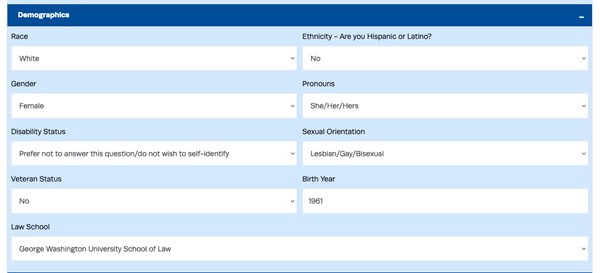Frequently Asked Questions - Demographics
Why should I provide my demographic information?
Providing your demographic information helps AHLA better understand our membership composition and tailor our programs and services accordingly. This information enables the Association to assess whether our membership and leadership reflect the breadth of the health law profession. Transparency about our membership demographics supports accountability in identifying and addressing potential barriers to meaningful participation for all members.
AHLA collects and analyzes this data to gain insights into the composition of our community. We are committed to fostering an inclusive environment where all members can fully participate in and benefit from AHLA's educational programming, publications, and volunteer and leadership opportunities.
AHLA's commitment to diversity and inclusion stems from our core values and mission. Creating an inclusive professional association strengthens our organization and the health law profession. By welcoming diverse perspectives and experiences, we enhance the quality of our programs, discussions, and decision-making processes. A membership that reflects the full spectrum of the health law profession helps ensure that AHLA remains relevant and valuable to all practitioners in our field.
Who does AHLA collect demographic information from?
AHLA collects voluntary self-identification data from our membership.
What demographic information does AHLA currently collect?
The Association provides members with the opportunity to voluntarily share information about their race, ethnicity, gender, age, sexual orientation, disability status, and veteran status. Additionally, AHLA offers members the option to include their pronouns in the membership directory. This reflects our commitment to creating an inclusive and respectful environment for all members of our professional community.
How and when does AHLA collect demographic information?
Demographic information is collected through voluntary self-identification on the initial online membership application and at the time of renewal. Members may also add or update their demographic information at any time through their myAHLA portal.
What is the data used for?
AHLA uses demographic data to compile aggregate statistics about our membership composition. This aggregate information helps inform the Association’s Board of Directors about our professional community. The data is used solely for informational and analytical purposes to support our mission of serving the health law profession.
What happens if I do not wish to self-identify or provide my demographic data?
Providing demographic information is entirely voluntary. Members may choose not to self-identify or may select "prefer not to answer" for any or all demographic questions. Non-participation in demographic data collection does not affect membership status, benefits, or opportunities in any way.
How is the data secured?
AHLA is committed to protecting member privacy and maintaining confidentiality. Individual demographic responses remain private and confidential within each member's AHLA record. The Association reports only aggregate, non-identifying statistical information to advance our understanding of our professional community. AHLA will never sell, rent, or provide individual demographic information to third parties. Any internal use of demographic data is reviewed by AHLA's Membership Vice President to ensure compliance with our privacy commitments and appropriate business purposes.
How can I update my demographic information?
Members can update their demographic information at any time by logging into their AHLA account and clicking on their name in the upper right-hand corner. From the dropdown menu, select either 'myAHLA Portal' or 'My Profile.'
In the 'My Profile' section, click on 'My Demographics' to access the demographic questions through a series of dropdown menus. Members may update their information or select 'Prefer not to answer this question/do not wish to self-identify' for any question at any time.
